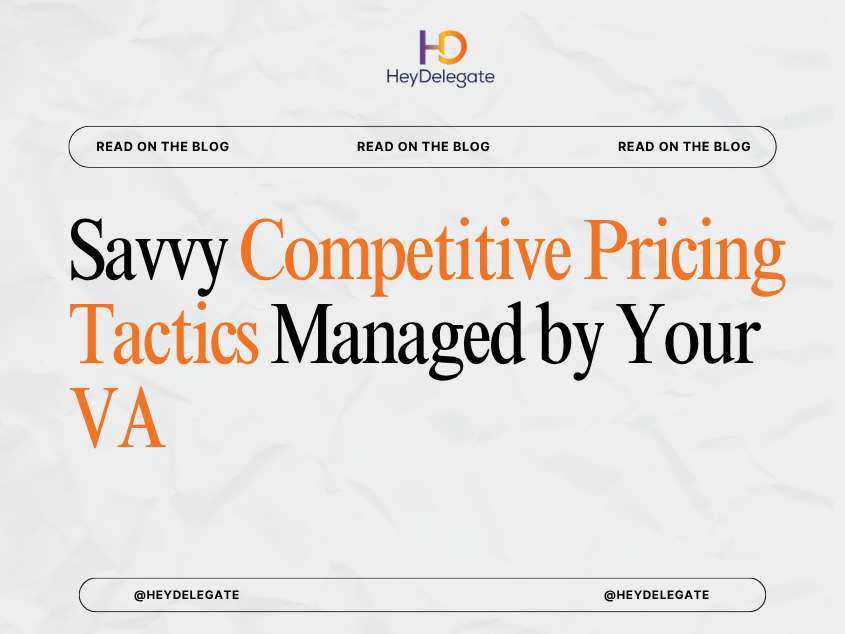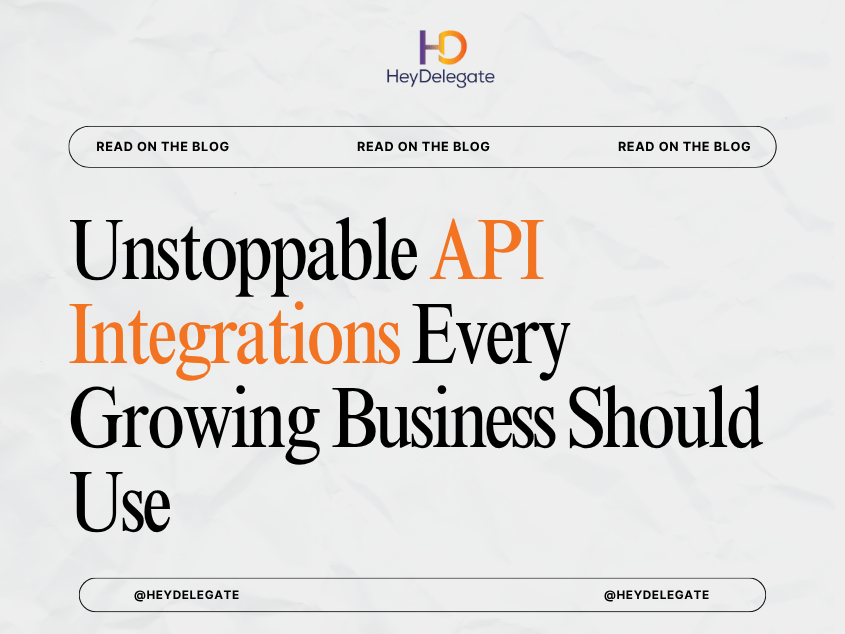In the world of e-commerce and online business, pricing strategy is everything. You could have a stellar product, a beautifully designed website, and the perfect marketing message but if your prices aren’t competitive, potential buyers will click away in seconds.
Today’s customers are savvy. With just a few taps, they can compare prices across dozens of platforms. This means your business needs to be strategic, dynamic, and data-driven when it comes to setting, testing, and adjusting your prices.
The good news? You don’t have to do it all alone. A Virtual Assistant (VA) with pricing management expertise can help you analyze competitors, track market changes, update product listings, and even manage automated pricing tools. When done right, these processes lead to better margins, faster conversions, and consistent revenue growth.
In this guide, we’ll explore powerful, savvy competitive pricing tactics your VA can manage to keep your business ahead of the curve without the stress of constant manual monitoring.
1. The Importance of Competitive Pricing
Before diving into tactics, it’s crucial to understand why competitive pricing matters so much.
In the digital marketplace, pricing isn’t just about covering costs and adding a markup, it’s about perceived value and market positioning.
Here’s what competitive pricing does for your business:
- Builds trust: Customers feel confident when your prices align with market expectations.
- Increases visibility: Competitive pricing improves rankings on marketplaces like Amazon and eBay.
- Drives volume: Fair, optimized prices lead to higher conversion rates.
- Boosts brand perception: A well-balanced pricing strategy makes your business look credible and professional.
However, manually keeping tabs on competitors can be exhausting. This is where your Virtual Assistant becomes a game-changer turning a time-consuming chore into an automated, insight-driven system.
2. Competitor Price Monitoring: Your VA’s First Line of Defense
The first step in any pricing strategy is knowing what the competition is doing. Your VA can take charge of this process by:
- Setting up competitor tracking spreadsheets: Monitoring similar products across platforms.
- Using pricing intelligence tools: Such as Prisync, Price2Spy, or DataFeedWatch.
- Scheduling weekly or bi-weekly reviews: So you’re always up-to-date on price shifts.
With clear parameters (product type, brand, quality, location), your VA can detect trends like:
- Which competitors run frequent discounts
- Which products maintain stable pricing
- What range attracts the most customer reviews
This insight allows you to adjust prices proactively not reactively.
3. Segmenting Competitors for Smarter Decisions
Not all competitors are created equal. A smart VA will categorize your competition into tiers:
- Direct Competitors: Offer the same or nearly identical products.
- Indirect Competitors: Sell alternatives or substitutes.
- Premium Competitors: Price higher but offer perceived extra value.
- Discount Competitors: Focus on low-price, high-volume strategies.
By tracking how each tier prices their products, your VA can help you find your ideal position in the market whether that’s premium, value-based, or low-cost leadership.
For example:
If your VA finds that your mid-tier competitors are consistently pricing 10% lower than you, it might be time to test new bundle offers or loyalty discounts.
4. Leveraging Dynamic Pricing Tools
Dynamic pricing is one of the most effective ways to stay competitive without constant manual intervention.
Your VA can help you implement and manage dynamic pricing software such as:
- RepricerExpress (for Amazon and eBay)
- IntelligenceNode (for omnichannel retail)
- Omnia Retail (for price automation)
These tools automatically adjust your prices based on competitor data, demand levels, or time-based factors.
Your VA can:
- Set the rules and thresholds (e.g., never go below 20% profit margin).
- Monitor performance dashboards.
- Report weekly on trends and anomalies.
This ensures that your prices remain both competitive and profitable, even when the market fluctuates.
5. Psychological Pricing Techniques Your VA Can Implement
Price psychology can have a profound impact on buyer behavior. Your VA can help you test and implement these proven tactics:
Charm Pricing
Setting prices like $19.99 instead of $20 triggers the perception of a deal.
Tiered Pricing
Offering three price options (basic, standard, premium) helps customers self-select while subtly nudging them toward the mid-tier option, the sweet spot for most sales.
Anchored Pricing
Showing a “regular price” next to a discounted price highlights value. Example: “Was $49.99, Now $29.99.”
Bundle Pricing
Your VA can create bundles (e.g., “Buy 2, Get 1 Free”) that encourage customers to spend more while feeling they’re saving.
Your VA can A/B test these strategies and track which ones yield the best conversion rates.
6. Monitoring Market Trends and Seasonal Shifts
Market demand isn’t static; it fluctuates with trends, seasons, and consumer sentiment.
Your VA can:
- Track Google Trends to identify rising keywords or product demand spikes.
- Analyze seasonal sales data to prepare early promotions (e.g., holiday, back-to-school, or summer essentials).
- Adjust pricing in advance to capitalize on peak demand periods.
For instance, if your VA identifies a growing interest in “eco-friendly packaging” or “home office accessories,” you can adjust pricing and highlight these features for added perceived value.
7. Competitor Promotions and Discounts Tracking
Another crucial element your VA can handle is promotion tracking.
Your VA can create a calendar of competitor discounts, flash sales, and coupon releases then suggest counterstrategies, such as:
- Launching limited-time bundles.
- Offering loyalty points or free shipping.
- Highlighting your unique selling points (e.g., “handmade,” “locally sourced,” “extended warranty”).
By maintaining a promotion tracker, your VA ensures your offers always stand out without cutting too deep into your margins.
8. Building an Internal Pricing Database
Having an internal database helps your business maintain long-term pricing consistency and data-backed decisions.
Your VA can organize a comprehensive pricing document that includes:
- Product SKUs and current prices.
- Cost of goods and profit margins.
- Competitor prices and links.
- Date of last price review.
This system streamlines updates, makes audits easier, and helps identify when a product’s pricing needs attention.
9. Using CRM and Analytics Tools for Pricing Insights
Pricing strategy shouldn’t exist in isolation. Your VA can integrate CRM and analytics data to see how pricing affects customer behavior.
They can pull reports from:
- HubSpot or Zoho CRM: Identify which leads convert based on pricing tiers.
- Google Analytics: Track bounce rate and checkout abandonment.
- Shopify Analytics or WooCommerce Reports: Measure sales lift after price changes.
These insights inform data-driven pricing decisions, ensuring you don’t rely on gut feeling alone.
10. Managing Multi-Platform Pricing Consistency
Selling on multiple platforms (Shopify, Amazon, Etsy, eBay) comes with the risk of price inconsistency.
Your VA can manage:
- Uniform pricing policies across all channels.
- Automated updates when pricing changes.
- Compliance with platform-specific minimum price rules.
They can also ensure currency conversions are accurate if you sell internationally, maintaining competitive parity across regions.
11. Cost-Plus vs. Value-Based Pricing Your VA’s Role
There are two dominant approaches to pricing:
- Cost-Plus Pricing: Adding a markup to the product’s base cost.
- Value-Based Pricing: Pricing according to perceived value and customer willingness to pay.
Your VA can research customer segments and competitor benchmarks to help determine which approach aligns best with your goals.
For premium products, your VA might recommend a value-based strategy supported by testimonials, quality visuals, and strong branding. For high-volume items, a cost-plus approach may be more effective.
12. Setting Up Pricing Dashboards and Reports
Automation and clarity are key. Your VA can set up pricing dashboards in tools like Google Data Studio, Airtable, or Notion to track:
- Competitor averages
- Your pricing history
- Margins and sales trends
- Product performance per price point
This turns pricing management into a data-driven discipline instead of guesswork.
13. Testing and Reviewing Pricing Strategies Regularly
Pricing isn’t a “set it and forget it” process; it needs consistent testing and refinement.
Your VA can schedule:
- Monthly reviews of pricing performance.
- Quarterly market analysis to adapt to new entrants.
- A/B tests on landing pages or offers.
Small, incremental changes can make a huge difference in profitability.
14. Communication and Approval Workflows
To ensure smooth collaboration, your VA should follow a clear pricing update workflow:
- Gather competitor and market data.
- Submit proposed pricing adjustments.
- Await approval before changes go live.
- Record all updates in the pricing tracker.
This process minimizes errors and keeps your brand messaging and pricing aligned.
15. Empowering Your VA for Strategic Pricing Leadership
With the right training and systems, your VA can evolve from a task executor into a pricing strategist, someone who brings insights, forecasts, and actionable suggestions to the table.
Encourage your VA to:
- Stay updated with e-commerce pricing trends.
- Propose experiments like limited-time discounts or new bundle options.
- Collaborate with your marketing team to align promotions with pricing goals.
When your VA understands how pricing ties into brand value and customer loyalty, they become an invaluable part of your strategic team.
Conclusion
A well-managed pricing system is one of the most powerful levers for profitability and your VA can make it happen efficiently and consistently.
From monitoring competitors and setting up dynamic tools to tracking performance metrics and suggesting strategic adjustments, your VA ensures your business always stays one step ahead. By trusting your VA with these savvy pricing tactics, you’ll not only maintain healthy profit margins but also build a brand that customers perceive as fair, trustworthy, and valuable. Get your VA today from HeyDelegate.




